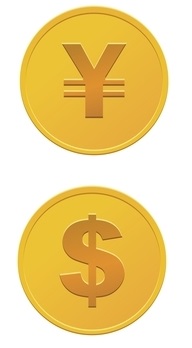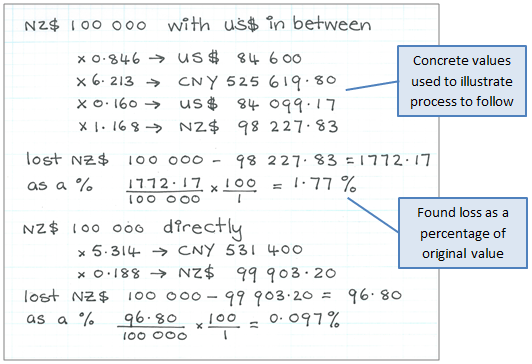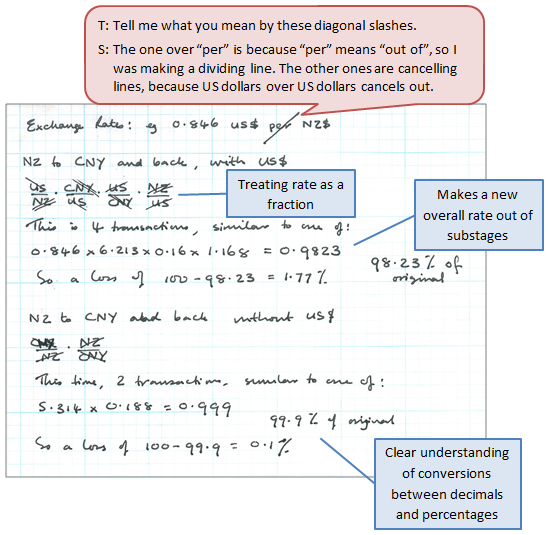The purpose of this activity is to engage students in an investigation that requires them to use rates, decimal and currency calculation to find a percentage difference.
This activity assumes the students have experience in the following areas:
- Calculate with decimals.
- Solve problems with rates.
- Calculate with simple percentages, especially with money.
The problem is sufficiently open ended to allow the students freedom of choice in their approach. It may be scaffolded with guidance that leads to a solution, and/or the students might be given the opportunity to solve the problem independently.
The example responses at the end of the resource give an indication of the kind of response to expect from students who approach the problem in particular ways.
 Task: In March of 2014, NZ and China brokered a deal to allow direct exchange between their two currencies (NZ$ and CNY, the Chinese Yuan). This removed the need to use in intermediate step of exchanging into US$.
Task: In March of 2014, NZ and China brokered a deal to allow direct exchange between their two currencies (NZ$ and CNY, the Chinese Yuan). This removed the need to use in intermediate step of exchanging into US$.
Use the exchange rates below to investigate possible savings if a sum of NZ$ is changed into CNY and then back into NZ$ with and without this direct exchange deal. Find the percentage of the sum involved that is 'lost' within the transactions.
NZ$ → US$ 0.846
US$ → NZ$ 1.168
US$ → CNY 6.213
NZ$ → CNY 5.314
CNY → US$ 0.160
CNY → NZ$ 0.188
The following prompts illustrate how this activity can be structured around the phases of the Mathematics Investigation Cycle.
Make sense
Introduce the problem. Allow students time to read it and discuss in pairs or small groups.
- Do I understand the situation? (Students may need background information about currencies and exchange rates.)
- What is an exchange rate? How does an exchange rate work?
- What information has been given and what more information might be needed?
- Can I anticipate what percentage might be lost? How?
- Does this look/sound like a problem I have worked on before? What kind of problem is this?
- What will the answer look like? (A percentage loss for each exchange system with calculations to support the percentage.)
Plan approach
Discuss ideas about how to solve the problem. Emphasise that, in the planning phase, you want students to say how they would solve the problem, not to actually solve it.
- What are the maths skills I need to work this out? (Rates are integral to the problem.)
- How could I show this problem using numbers, equations, pictures, graphs, tables or materials?
- What strategies can I use to get started?
- Should I start with a tidy amount in NZ$? What amount would be good? Why?
- What tools (digital or physical) could help my investigation?
Take action
Allow students time to work through their strategy and find a solution to the problem.
- Have I shown my workings in a step-by-step way?
- Does my answer seem correct? Is it close to my estimation?
- How could I make sure that I haven’t missed anything?
- Do the percentages seem reasonable?
- Do my results look to same or different to others? Why could this be?
- Is there another possible answer or way to solve the problem that is more efficient?
Convince yourself and others
Allow students time to check their answers and then either have them pair share with other groups or ask for volunteers to share their solution with the class.
- What is the percentage lost with each scheme?
- Have I shown clearly how the percentage was found?
- How would I convince someone else that my calculations are correct?
- Is there some mathematics that I need to learn?
- What does my answer mean for companies that exchange large amounts of money?
Examples of work
Work sample 1
The student uses currency exchange multipliers to convert between currencies and to find the percentage cost of the exchange, with guidance.
Click on the image to enlarge it. Click again to close.
Work sample 2
The student uses currency exchange multipliers to convert between currencies and to find the percentage cost of the exchange.
Click on the image to enlarge it. Click again to close.
Work sample 3
The student uses currency exchange multipliers to convert between currencies and to find the percentage cost of the exchange.


